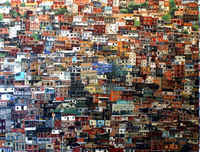The city today in Latin America and the Caribbean
In recent decades, Latin America and the Caribbean have experienced a noticeable growth in urbanization. In the nineties, the region’s urban population (human settlements comprising two thousand or more people) was 71%, and by 2025 it will reach 85%. 42% of the population lives in 49 cities of over a million inhabitants.
Amongst the major cities are Sao Paulo (17.7 million), Mexico (17.4), Buenos Aires (11.2), Rio (10.8), Lima (8.3), Bogotá (8), Santiago (5.3) and Belo Horizonte (5.3). This megalopolization is related to: a) poverty that prevails in the rural countryside, and b) the importance of the major cities and the influence on the countries as a whole. This is reinforced and consolidated by globalization and the technological revolution which has extended the horizons of capitalism to a world level, and has led to an economic de-frontierization of the national territories.
The main consequences have been the existence of a growing trend towards the territorialization of the economy and the localization of work and investments of companies in cities which can count on facilities that will be beneficial for them. This new urban economic dynamic is not looking so much for a connection with the environment but to prioritize connections with many definite and specialized places. "Globalization opens up the territories of the world, and divides these areas into fragments. Some which have local systems of government which later comply with the rules of larger governmental systems (1 ) . “
Each city is fighting to be part of this new global makeup, and consolidates the divide between modern sectors prepared to include themselves in the world of global competition, and other which should withdraw into the economy of survival or production for the local markets. Spatial fragmentation goes hand in hand with the segregation of low-income sectors where new pockets of poverty are emerging that consist of people “not functional” in the global world.
But the poverty that exists in Latin America and the Caribbean also has to do with the fact that this region has the worst income distribution throughout the world. The World Bank’s points out that its main concern about the standard of economic and social development in the region is not poverty in itself but rather the way in which income is being distributed (2 ) . And that is, in fact, 10% of the richest people in Latin America and the Caribbean own nearly half the wealth. With only a small improvement in the distribution of equity, the reduction of poverty would be achieved on the same scale that would produce many years of economic growth.
Poverty is an insurmountable phenomenon in the region, where three of every five people live in poverty, primarily economic. This poverty is closely linked with employment and lack of suitable jobs in the formal sector of the economy, forcing most people to earn their income in the black market. At the end of the nineties decade 48 out of every 100 urban workers in the region were employed in the black market. Out of these, 32 were living in shanty towns.
As a result of the situation some conclusions were expressed and taken into account:
a) The informalization for society as a whole
.
b)
The "urbanization of poverty”
,
which in some cities 60% live in (human settlements located within high risk areas which are hazardous, unsafe, inaccessible, without services, with substandard housing in abundance).
c)
The emergence of new social urban problems
, resentment towards regulations for social coexistence and growing levels of violence and crime.
d) The
inability to govern.
e) The predation
of the environment
.
f)
The mental and psychological deterioration of one’s state of mind.
g)
The worsening of land
and housing pro
blems
. We will refer to this problem in the next presentations
(1 ) “Transformaciones económicas y reorganización territorial en la Región Metropolitana de Madrid”; EURE, Santiago, No. 80, Mayo, pp. 141-16, Michalet C.A:, 2004, citado en De Mattos.
(2 ) In this respect refer to:” The Achilles Heel of Latin America: State debate on inequality”, Florencia Jubany and Judy Meltzer, FOCAL, Political document, Foundation for the Americas, 2004.
Georeferences
The Volunteer translators for housing rights without frontiers of IAI who have collaborated on the translation of this text were:


